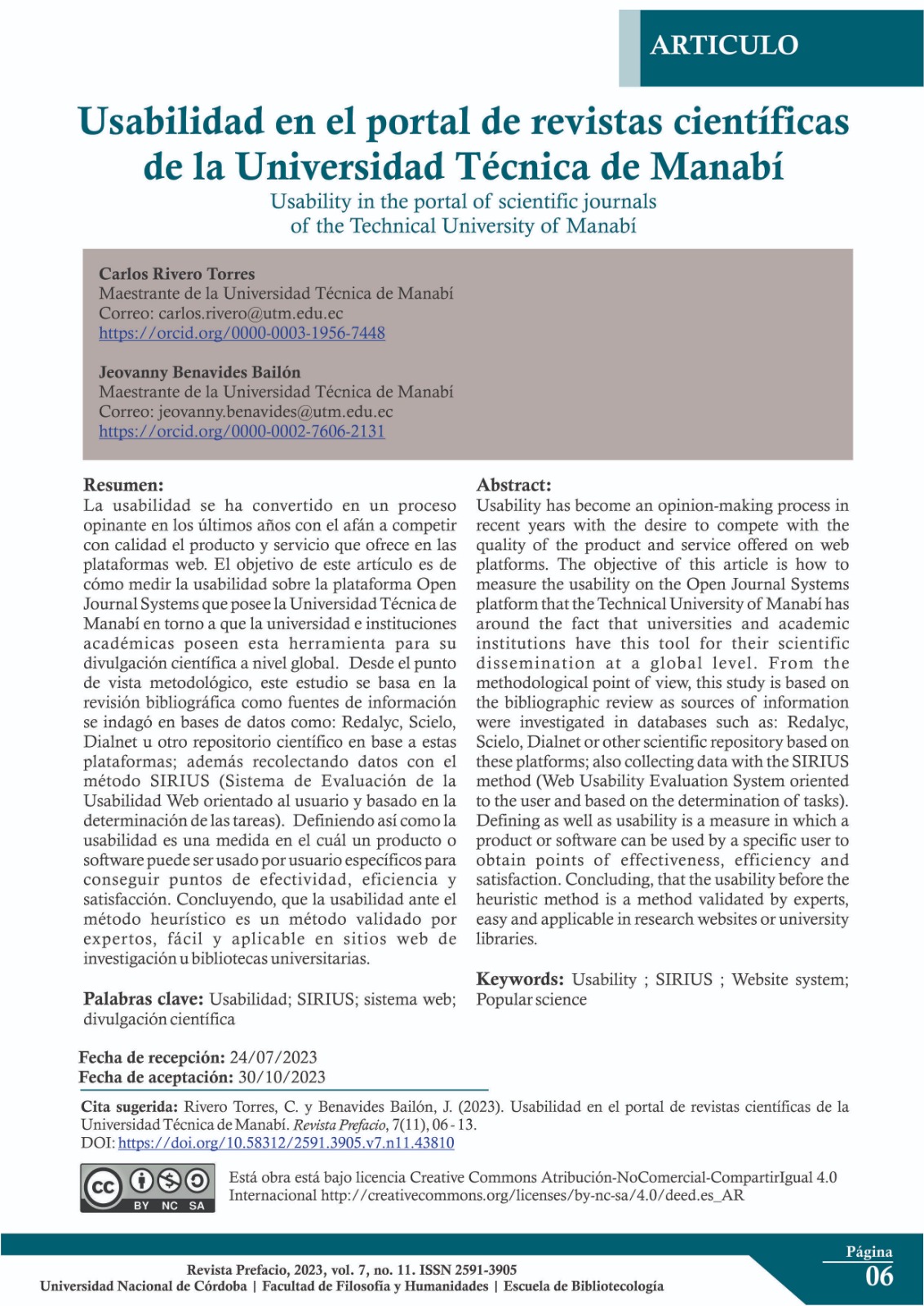Usability in the portal of scientific journals of the Technical University of Manabí
DOI:
https://doi.org/10.58312/2591.3905.v7.n11.43928Keywords:
Usability, SIRIUS, Website system, Popular scienceAbstract
Usability has become an opinion-making process in recent years with the desire to compete with the quality of the product and service offered on web platforms. The objective of this article is how to measure the usability on the Open Journal Systems platform that the Technical University of Manabí has around the fact that universities and academic institutions have this tool for their scientific dissemination at a global level. From the methodological point of view, this study is based on the bibliographic review as sources of information were investigated in databases such as: Redalyc, Scielo, Dialnet or other scientific repository based on these platforms; also collecting data with the SIRIUS method (Web Usability Evaluation System oriented to the user and based on the determination of tasks). Defining as well as usability is a measure in which a product or software can be used by a specific user to obtain points of effectiveness, efficiency and satisfaction. Concluding, that the usability before the heuristic method is a method validated by experts, easy and applicable in research websites or university libraries.
Downloads
References
Bermello-Crespo, L. (2005). Los estudios de usabilidad en sitios webs de bibliotecas universitarias. Ciencias de la Información, 36(2), 31–52. https://www.redalyc.org/pdf/1814/181417874002.pdf
Fernández-Casado, P. (2018). Usabilidad web. Teoría y uso. Ra-Ma
Garrett, J. J. (2003). The elements of user experience: User-centered design for the web and beyond. New Riders.
Halim, F. y Handoko, H. (2019). Usability evaluation for digital library: Acase study of library websites, Mikroskil. Fourth International Conferenceon Informatics and Computing 2019. Electrical and Electronics. 5(1), 1-6. doi: http://doi.org/10.1109/ICIC47613.2019.8985768
Kous, K., Pušnik, M., Heričko, M. &Polančič, G. (2020). Usability evaluationof a library website with different end user groups. Journal of Librarianship and Information Science, 52(1), 75–90. doi: https://doi.org/10.1177/0961000618773133
Muñoz-Egido, D. yVianelloOsti, M. (2017). Evaluación de usabilidad delos portales web de las bibliotecas universitarias españolas a partir de un modelo heurístico cognitivo- emocional. Revista española de Documentación Científica, 40(1). doi: https://doi.org/10.3989/redc.2017.1.1379
Nielsen, J. (2000). Usabilidad. Diseño de sitios web. Alhambra Editorial.
Nielsen, J. (1992). Finding usability problems through heuristic evaluation. Proceedings of the SIGCHI Conference on Human Factors in Computing Systems. Computing Machinery.7(2). 373-380. doi: https://doi.org/10.1145/142750.142834
Krug, S. (2015). No me hagas pensar. Grupo AnayaPublicaciones Generales.
Pailiacho, V., Garcés, E., Freire, J., y Balseca, M. (2022). Usabilidad del software: Una revisión sobre su evolución conceptual y parámetros de evaluación. Revista Ciencias y Tecnología, 16(2), 121-134, https://revistas.uclave.org/index.php/pcyt
Roa-Martínez, S. y Vidotti, S. A. B. G. (2020). Eye tracking y usabilidad en ambientes informacionales digitales: revisión teórica y propuesta de procedimiento de evaluación. Revista Transinformação, 32(1), 3-14. doi: http://dx.doi.org/10.1590/1678-9865202032e190067
Saldías, L, W. y Reyes-Lillo, D. (2021). Evaluación de usabilidad de sitios web de bibliotecas de universidades públicas chilenas a partir del método SIRIUS. e-Ciencias de la Información, 11(1). doi: http://dx.doi.org/10.15517/eci.v11i1.41476
Suárez, M. (2011). SIRIUS: Sistema de evaluación de la usabilidad web orientado al usuario y basados en la determinación de tareas críticas [Tesis Doctoral]. Universidad de Oviedo, Oviedo, España.








